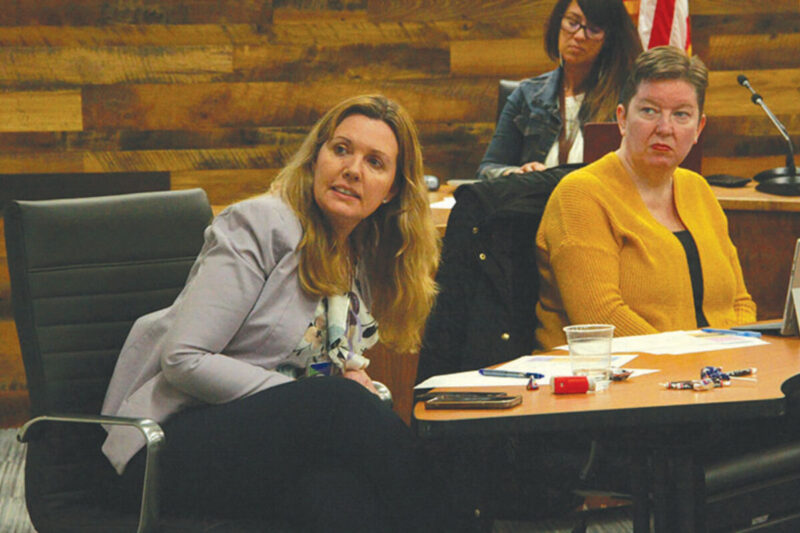Benny Westcott
The Sweet Home City Council identified 16 goals – including funding for an upgraded wastewater treatment plant and a new library – for the 2023-24 fiscal year during its meeting Tuesday, April 11.
A resolution to adopt these goals is set for an April 25 vote.
Specific goals for the Mahler Water Reclamation Facility included funding and the creation of bid documents, plus such upgrades as a new backwash pump, variable drive controllers and a raw water control valve to replace a failed one in the intake building.
Officials have repeatedly noted that the outdated facility, which was built in 1947 and last upgraded in 1974, struggles with capacity issues.
In 2001, the city reached an agreement with the Oregon Department of Environmental Quality to address ongoing wastewater system overflows and discharge violations caused primarily by inflow and infiltration in the collection system, which is water that enters the sewer system through deteriorating pipes and cross-connections with storm drainage.
Last August, the plant experienced unusually high flow levels, followed by die-offs of biological life in its aeration basin, on a pair of Tuesdays two weeks apart. Residents complained about odors during the events.
More recently, the DEQ issued the city a $22,445 civil penalty for more than 125 violations of state water-quality protection law over several years. A Jan. 19 letter cited the city for failing to meet pollutant limits and conduct wastewater monitoring required by its wastewater permit, and for violating state law by discharging raw sewage and non-disinfected wastewater into Ames Creek.
New Library
The council is also looking to find a location, obtain funding and purchase property for a new Sweet Home Public Library.
According to Library Services Director Megan Dazey, the current building lacks adequate space. “We need more space for so many things,” she explained at a Jan. 24 council meeting. “We’re getting daily requests for meeting space for people in the community.
“We’re limited in the amount of kids we can comfortably have for story time and the number of teens that can come over after school and hang out. We’d like to have separate areas for those that want to read and those that just need a safe space to be.”
“We’ve been asking for money,” City Manager Kelcey Young said. “We probably aren’t going to receive it yet, but we can work on receiving it next year. Before they’re willing to give us funding, they want a location.”
Park Improvements
Park improvement goals included completing Phase 1 of Quarry Park, which would entail opening the land for camping and kayaking, and improving upper Sankey Park with a new bandstand to replace an historic structure razed in 2021 due to its dangerous condition and the infeasibility of its rehabilitation.
City officials have discussed Quarry Park as the possible future home of the Oregon Jamboree as well as for outdoor recreation and sporting events.
“I think if we can get that Quarry Property done, tourism is going to change,” Councilor Dave Trask said. “There aren’t very many places in the United States that have a river and three ponds. So I think that could be a big plus for us from that side of the tourism part.”
Another tourism-related goal involved a possible partnership with the Army Corps of Engineers for a Foster Lake Train Station.
“I really want to do (that),” Councilor Angelita Sanchez said. “If we’re going to work on a tourism plan and Quarry Park, it all ties in together to have kayaks, electric bikes and whatever we can have down there to do a one-two punch.
“I just feel like it’s going to be kind of like pulling teeth to do downtown Main Street and it’s going to take a little bit more time than we’re anticipating,” she continued. “If we can have something new and fresh that draws people to that side of town, I think that’d be really exciting.”
Downtown Projects
Downtown goals included the Phase 1 completion of a downtown streetscape plan, which was formally adopted by the council in March 2022.
Developed by Eugene-based Dougherty Landscape Architects, the project seeks to establish a standard plan for landscaping, trees, lighting, signage, street furniture and parking in an area identified as the Main and Long street corridor between Ninth and 18th avenues.
Councilors began pursuing the project in early 2020, finally approving a contract with DLA in January 2021. Public meetings to solicit feedback were held throughout that year.
“The goal is to make downtown Sweet Home a more appealing place for residents and visitors by beautifying the public right-of-way and making the area more pedestrian-friendly,” Community and Economic Development Director Blair Larsen said at a March 2022 council meeting. “Private businesses and property owners will be able to capitalize on this increase in foot traffic by beautifying their own properties and increasing the offered products and services in the area.”
He added at the time that the plan allowed city staff to move forward with phasing and identifying potential funding sources.
“The key to those programs and grants is showing that you have a project that has been fully vetted by the public,” he said.
“That makes your project much more competitive, because funders don’t like seeing a project get funded and then have the public demand changes midstream or even after it’s done. Having that officially adopted document is really an important step for opening ourselves up to those opportunities.”
DLA estimated a total construction cost of $7,700,720, but Larsen expected that the actual number would be higher because the initial figure did not account for utility relocation or stormwater quality infrastructure. He also suspected that the project would have to be split into portions due to its size.
“The full buildout of these plans is a very large undertaking and will require many years, cooperation from community partners, significant political will, and a big investment of public funds,” he said in March 2022. He wasn’t immediately certain where the city would secure funding but was optimistic about opportunities in the Infrastructure Investment and Jobs Act, which was signed in November 2021, as well as state programs.
At this most recent meeting, Councilor Lisa Gourley said, “If we’re going to help our community feel better about themselves and attract businesses that want to be located here, we’re going to have to make some plans to invest in these aspects. It’s just the way it is. We have to put our money where our mouth is.”
Young described the streetscape project as “a basic beautification of downtown,” adding that it tied in with setting up an electric vehicle charging station on 10th Avenue – another goal – for which construction is already slated.
Electric Vehicle Stations
The council voted in December to authorize Young to sign a Pacific Power Oregon Clean Fuels Electric Mobility Grant Agreement that would bring two electric-vehicle direct-current fast-charging stations to Sweet Home, specifically on 10th Avenue, a road to be converted to one-way traffic to add head-in (90-degree) parking spaces downtown.
Pacific Power administers the Oregon Clean Fuels Electric Mobility grants, or e-mobility, program, which offers grants for improvements associated with electric vehicles, from fleet conversions to charging stations. This grant covers an entire project, with no local match required. In addition, the program may provide up to 75% of the funding at a project’s beginning, with the remaining 25% upon completion.
City staff submitted an application to Pacific Power for an e-mobility grant in August 2022, proposing that the new parking on 10th Avenue include two electric-vehicle direct-current fast-charging stations.
Larsen noted that Sweet Home’s position as the easternmost community along Highway 20 on the west side of the Cascades made it ideal for travelers driving from the coast to Central Oregon.
“This can benefit Sweet Home’s downtown area, as travelers often patronize businesses next to charging stations while they wait for their vehicle to charge,” Larsen wrote in his December 2022 request for council action.
“Even if the cost of this system only paid for itself and then went to the company (that’s) running it, it would still be an amenity downtown that we don’t have right now,” he said.
“And it would still lead to Sweet Home being on the map when it comes to that charging infrastructure being a destination point.”
The nearest publicly accessible electric vehicle charging stations are currently in Lebanon. However, these level 1 or 2 chargers require several hours. Direct-current stations can charge a vehicle in less than one hour, and the nearest station of that type is in Albany. The nearest such stations to the east of Sweet Home are in Sisters.
The proposed grant award is for a maximum of $200,000.
The city will own the stations. Several firms manage charging stations and are paid only through usage fees. Larsen noted in his December 2022 RCA that these stations do not currently produce a lot of revenue but can at least pay for their own operating costs.
“Staff recommend seeking a firm to manage the charging stations for the city in such a manner that they are entirely self-sustaining or bring revenue to the city,” he wrote. “If any revenue is generated from the charging stations, it could be directed to downtown improvements and events.”
Other goals outlined at the meeting included:
— Creating a traffic officer plan.
“I think it’s a needed position, and I think it will have a positive impact on our community and traffic safety,” Police Chief Jason Ogden said.
— Chip-sealing certain town roads. Public Works Director Greg Springman said his team is currently producing a list of locations for that work.
— Completing a transportation systems plan and working on a parks master plan.
— Creating an online dashboard for city goals to allow the public to monitor their progress.
— Reviewing the city’s franchise agreements and fees.




